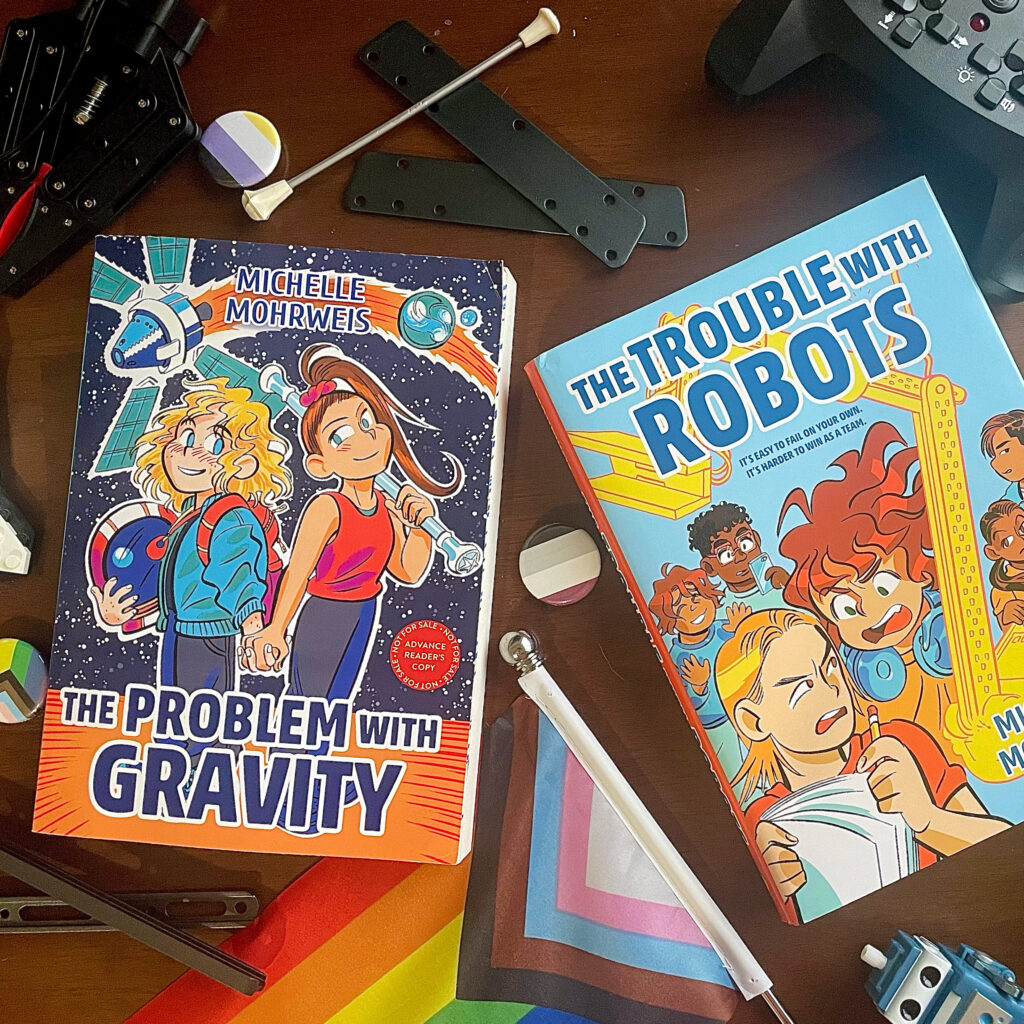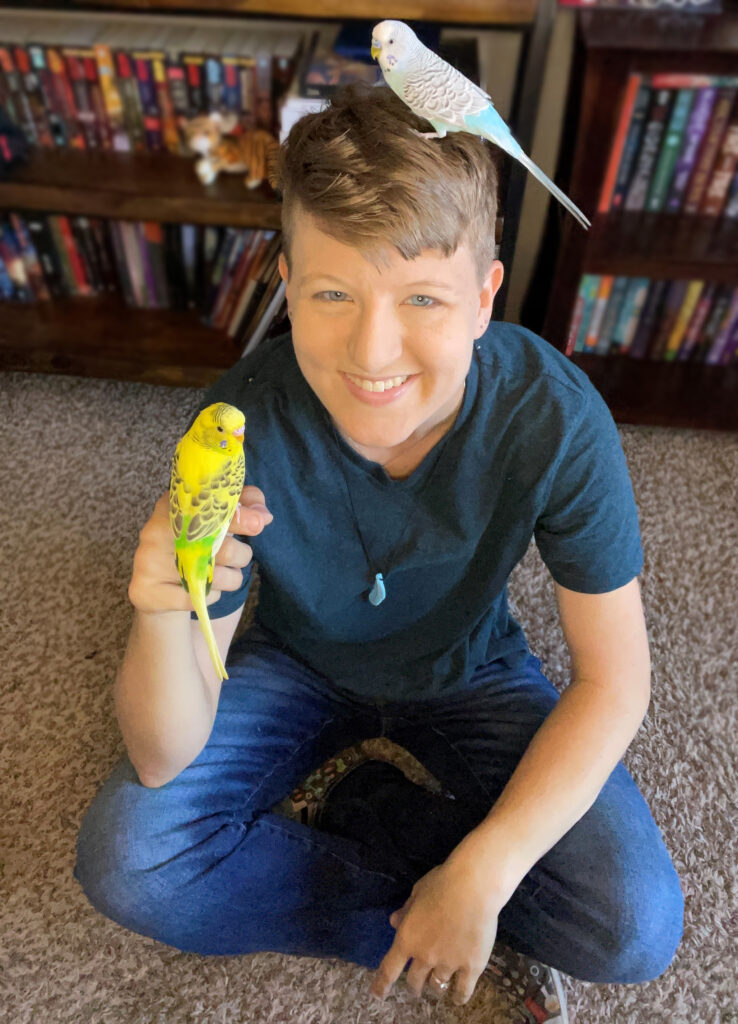Seeing Yourself in a Story, a guest post by Michelle Mohrweis

Stories have a unique power, a way of sweeping us off into other lives and adventures. They let us escape from our worries, let us dive into fantastical places we might never imagine. They let us experience triumph and joy and sadness, all alongside characters we come to love.
I probably don’t need to tell you that though. If you’re reading this post, you know the power a story has to sweep us away.
But did you know that for some of us, stories can also be a sort of comfort, a thing that shows us we are normal and accepted and valid? This is especially true of contemporary stories, where instead of sweeping us away, they often will stick us right down in our own world with situations so like our own.
ADVERTISEMENT
ADVERTISEMENT
I think that’s what draws me to writing contemporary. It’s why I’ve enjoyed writing books like THE TROUBLE WITH ROBOTS, which follows a group of kids trying to save their robotics team, and THE PROBLEM WITH GRAVITY, which takes you along with two girls as they enter an engineering contest and develop feelings for each other.

Contemporary may not always be as flashy as fantasy, or as thrilling as adventure stories, but there’s still something incredibly compelling about it. There’s something wonderful about following along with everyday characters who are going through familiar challenges.
I remember when I was an uncomfortable, closeted, and rather confused kid. It was before I was diagnosed as autistic and ADHD, when I struggled to understand why I didn’t do things the way so many others did, why I had so many struggles with food and clothing textures and figuring out the right things to say. In those days, I often found myself drawn to the “awkward” and nerdier characters. The quieter characters who didn’t quite fit in, who preferred reading and solitude, and who often grappled with being just a little bit lonely.
At the time I didn’t really know why I liked those characters so much, but looking back, it’s because I could see myself in them. I could watch them live their lives, pursue their passions, and find friends… and through that I could imagine it for me too.
That’s the power of a story.
Stories let us see ourselves doing things and having adventures. They let us imagine ourselves in those places and know that we are valid. It’s why I write contemporary books with openly neurodivergent and queer characters.
I want neurodivergent kids to be able to read about characters who struggle with crowds and meltdowns, who chew on stim necklaces and rock on their feet and sometimes hyperfixate on the worst possible thing, but who also are so creative and passionate and excited, ready to dive headfirst into their special interests and make the friendships where they can bounce questions around and be total nerds together and never feel embarrassed for who they are.
I want queer kids to see characters like them, whether it’s through queer first crush plotlines like in GRAVITY, or a character figuring out their lack of interest in crushes at all, like in ROBOTS. I want them to see characters who are like them that get to live their lives and be who they are without shame.
I want my queer and neurodivergent readers to know they aren’t alone. They aren’t a dirty secret, or a child incapable of being a hero in their own story. They can be whomever they want to be. They can be the kid who leads the robotics team, who is so determined to take the team all the way to the world championship. They can be the space loving girl who just wants to figure out how to talk to her crush without getting overwhelmed and running away. They can be the confident baton twirler, or the artist, or the kid who manages to help everyone else hold things together.
ADVERTISEMENT
ADVERTISEMENT
And finally, I want kids who are nothing like my characters to read these books too. I want them to see other lives and other perspectives, to gain an appreciation for the differences we all have, and empathy for others. To have fun reading an interesting story, even as they learn about lives different from their own.
Books have that power. When kids read books with characters like them doing incredible things, it lets them picture themselves in that spot too. When kids are going through tough times, reading books about characters like them dealing with the same can help them see that things are not impossible, help them realize that they can and will navigate their own challenges too. And when kids read about characters who may be nothing like them at all, it helps them understand and accept others.
That is why I write.
Meet the author

Michelle Mohrweis is a STEM Educator and space enthusiast. When not writing, they can be found launching paper rockets down the middle of their street. They live with their husband and two dogs in Colorado, where they enjoy hiking and hogging all the best spots beside the heater when it gets too cold. Follow them on Instagram @MichelleMohrweis and visit them on the web at MichelleMohrweis.com.
Links:
Instagram – @MichelleMohrweis
TikTok – @WritingRobots
Website– michellemohrweis.com
About The Problem with Gravity
A heartfelt selection for STEAM, LGBTQ+, and neurodivergent readers, this companion novel to The Trouble with Robots charmingly explores first crushes.
Autistic seventh-grader Maggie Weir loves spacecraft, but aerospace engineering isn’t the only thing that gives her butterflies: she’s teamed up with the amazing, baton-twirling Tatum Jones for an engineering contest! It’s an out of this world chance for Maggie to tell Tatum, her long time crush, how she feels. Only, Tatum is distracted with her own troubles at home. Worse still, when Maggie learns that her dad wants to move to Houston, her whole universe gets shaken up! Now she has a big decision to make: does she stay with her mom and remain in Tatum’s orbit, or does she launch her dreams of visiting NASA by following her Dad? If the stars are meant to align between these two, they’ll both have to admit their feelings before Maggie leaves forever.
An easy-to-follow, dual perspective narrative that compassionately explores themes of separation, healthy friendship, and sibling rivalry. Another lovable cast of characters in the Barton Junior High universe!
ISBN-13: 9781682635957
Publisher: Holiday House
Publication date: 09/26/2023
Age Range: 8 – 12 Years
Filed under: Guest Post
About Amanda MacGregor
Amanda MacGregor works in an elementary library, loves dogs, and can be found on BlueSky at @amandamacgregor.bsky.social.
ADVERTISEMENT
ADVERTISEMENT
SLJ Blog Network
Should I make it holographic? Let’s make it holographic: a JUST ONE WAVE preorder gift for you
This Whole Interview Is a Mistaco: And I Get to Talk to Eliza Kinkz in the Course of It!
Halfway There: A Graphic Memoir of Self Discovery | Review
Fifteen early Mock Newbery 2026 Contenders
When Book Bans are a Form of Discrimination, What is the Path to Justice?
ADVERTISEMENT







